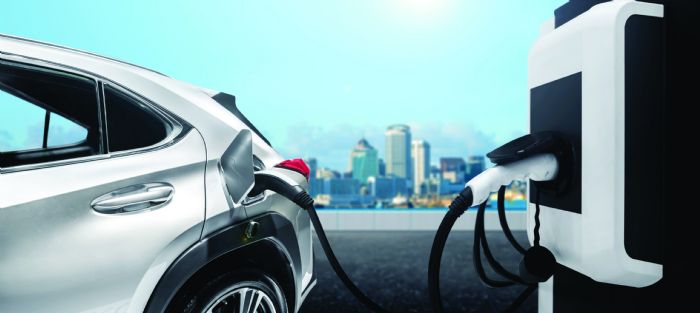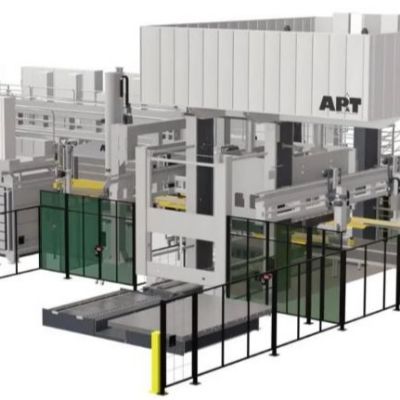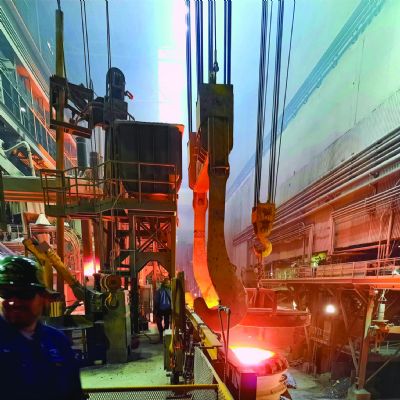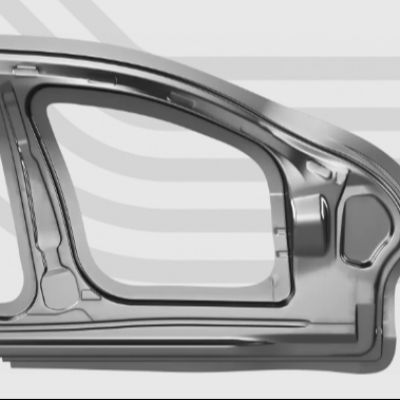Advanced aluminum alloys represent the second-most-used material in the auto industry and the fastest-growing material in the design of new cars and trucks, according to Drive Aluminum. As with their steel counterparts, aluminum providers partner with automotive stakeholders to develop holistic technology packages to achieve vehicle engineering objectives, and develop and deploy higher-strength alloys and closed-loop recycling technologies designed to add significant economic value.
New-generation steels and aluminum alloys can help provide protection while meeting lightweighting goals needed to keep battery power sufficient and efficient.
Of course, metal formers and fabricators serve on the front lines in shaping these light but tough materials into all manner of parts. Beyond battery cages, other BEV opportunities include rear underbody components, motor housings, gear boxes and main transmission parts, engine cradles and cross members, dashboard components, flooring, fender aprons, and the rear axle housing.
To help part suppliers meet automaker needs, resources are available.
For example, on the steel side, version 7 of the AHSS (advanced high-strength steel) Application Guidelines—free for public use as a mobile-friendly online database at www.ahssinsights.org—was released in 2021 and allows users to browse and search to quickly find specific information of interest. The website includes some 150 articles with 1000 citations, with many linking back to the original sources. The AHSS Applications Guidelines presents an overview of 15 types of sheet-steel grades, ranging from ultra-low carbon steels to AHSS and the latest 3rd-Gen steels. The online format enables timely updates to keep pace with the development of new technology and grades.
Hot Stamping Key Player in BEV Production
Hot stamping has evolved as a prime process to shape tough materials for use in BEV applications, so a closer look at this process segment is in order.
“Globally, we are seeing a general trend of automotive OEMs increasing their outsourcing of body and chassis components for BEVs,” explains Paul Belanger, R&D director North America for Gestamp. “In the United States, we see a bit of this trend, but also a significant increase in the overall BEV business. More electrified platforms are coming onto the scene as well as higher annual vehicle volumes. The number of new automotive OEMs, such as Rivian, Canoo, Lordstown and Lucid, also provides an increase in body- and chassis-component opportunities.”
BEVs require changes in body architecture to handle energy-absorption demands brought on by the weight of heavy batteries in the vehicle floor.
“This proves especially demanding in the bodyside structure,” says Belanger, “where side-impact events must be managed.”
How does this affect metal formers?
“This opens up a new field of what we call ‘extreme-size’ parts,” Belanger explains. “These large, one-piece hot stampings integrate several components. A good example: the bodyside reinforcement structure, or door ring, where the individual A and B pillars, sills, roof rails and hinge pillars all can be combined. Here, different material thicknesses and strengths assemble into one overlap patch blank. These blanks are first spot welded and then hot stamped into a single piece all at once. Extreme-size parts offer higher quality standards and tolerances at a lower cost and lower weight. These parts also feature lower assembly costs due to fewer parts to build into a vehicle.”
Gestamp reports expanding this approach into other areas of the body structure such as floors, rear rail systems and battery-ring structures—nearly all of the body structure.
“We believe this to be a significant step in electrification,” offers Belanger, “while protecting the battery in various crash events—a key requirement for BEVs.”
What challenges does Belanger see in supplying BEV parts, be it material availability, knowledge on forming unique materials or designing parts and processes?
“Material forming and joining technologies for the BEV battery boxes appear to be quite dynamic,” he says. “Many first-generation battery boxes have included massive use of aluminum extrusions, with internal aluminum structures to protect the battery cells. These boxes, often referred to as ‘cells-to-modules,’ include multiple joining technologies such as laser and hybrid welding, friction stir welding and gas-metal-arc welding. Due to the thermal distortion with these types of joining techniques, machining of critical surfaces is required to bring the parts into acceptable tolerance. The latest trends we see show that the responsibility to protect the battery cells is transitioning from the battery box to the body-in-white. These new-generation boxes, often referred to as ‘cells-to-pack’ or even ‘cells-to-body,’ are becoming less structural, simpler and significantly less costly. As a result, we see battery trays transitioning back to steel, formed with conventional methods.”
Overall, Belanger concludes, “the growth in BEVs provides significant opportunities to incorporate innovative forming processes coupled with novel product designs to develop cost-effective, lightweight safety solutions. Concepts such as extreme-size hot-stamped parts offer body complexity and cost reduction while improving vehicle safety. The rate of change in the automotive industry, driven by the transition to BEVs, will be an interesting and exciting journey.”
Is Your Production Line Up to Snuff?
While automotive-parts suppliers currently contribute 50 to 55 percent of the value of a vehicle powered by an internal-combustion engine (ICE), that might shrink to 35 to 40 percent for a BEV, according to a PwC report. This means greater competition for contracts. To best position themselves to take advantage of the BEV trend and the expected increase in unique forming of unique materials, part producers must ensure the flexibility and productivity of press-line equipment, including coil handlers, presses, transfer systems and conveyors.
BEV needs certainly will test the flexibility and capability of a stamping press. Here, an investment in servo-powered machines can pay off. Press requirements for exacting, tight-tolerance parts produced from tough materials, according to Stephan Robertson, general manager and vice president of sales and operations for press manufacturer Simpac, certainly include “excellent ram parallelism, minimum bed deflection and perpendicularity within 0.05 mm.”
Feeding the presses demands beefed-up coil handling and straightening systems. Time and again, MetalForming has published case histories where decisions to invest in more-robust coli-handling equipment pay off over tempting fate by overtaxing machinery with specifications mismatched for the material application.
In many cases, transfer systems get the call to move automotive parts through the press line, and if correctly specified and integrated can allow presses to perform at their maximum capabilities. Producers of this technology see the BEV trend.
“The overall increase in new programs and new EV OEMs is a big part of our growth,” reports Paul Stirrett, vice president of sales and marketing for Linear Automation Inc. “Some are building brand-new facilities and need all-new metal forming equipment, so this definitely is a very positive trend for equipment builders. We’ve already been involved in supplying transfer technology for battery-cooling components—one of many new BEV product lines.”
Lamination stamping is another product line experiencing an uptick, according to Stirrett, with electric motor drives, offering ever-increasing capacity and efficiency, gaining in popularity. Metal formers should pay attention to this segment and consider investment in assembly automation to take best advantage. And, with electric-grade steels in demand, Stirrett recommends that part providers educate themselves on these materials.
In sum, he says, “if you are in the powertrain business, you need to adapt your business for BEVs.”
And again, going back to data reflecting greater competition in the BEV market as compared to ICE vehicles, parts suppliers need optimal performance of all line components. This includes conveyor systems, according to Kyle Rhodes, vice president of business development for Magnetic Products, Inc. He, like other producers of press-line equipment, has noticed the BEV uptick. He urges metal formers to look closely at how they handle scrap, as poor scrap handling can drastically cut productivity and eliminate play in the BEV game.
Examine scrap-handling-related downtime as well as excessive downtime at job changeover due to conveyor repositioning, Rhodes advises, noting that modular conveyor solutions and newer low-maintenance conveyor technology, and resulting productivity gains, can help capture and keep BEV contracts.
Unique Volume Pressures for Metal Former
While many metal formers and fabricators prefer to stay tight-lipped about BEV impacts on their business, rest assured that many auto-part suppliers will be experiencing the ramifications at some point. Already feeling the impact is Bill Adler, president of Stripmatic Products, Inc., a Cleveland, OH-based supplier of metal tubular shapes to automotive and other industries.
“New BEV work requires us to shift from high-volume production mode on all of our existing ICE platform work to low- to medium-run mode as demand ramps up,” Adler says. “Purchasing small volumes of materials has become much more difficult in today’s market and comes with higher costs than we quoted. This makes job changeovers much more critical to profitability and scheduling. As volumes of these parts increase, eventually we’ll have to add capex to meet these volumes.”
BEV contracts awarded thus far to Stripmatic require parts similar to those the company already produces, Adler reports, but have necessitated development of a new automated joining process and expansion of part-size limitations.
Interestingly, “most of the BEV parts we produce originally were sourced to suppliers in Asia,” he says. “This reduced the normal 18-mo. development time on our end to 5 to 6 mo. We jumped through hoops to make that happen.”
What challenges does Adler see in continuing to supply BEV parts?
“My biggest concern is the continuing labor shortage,” he says. “I do expect steel pricing and availability to continue improving over the next 1 to 2 yr.”
Another challenge involves bringing in the equipment Stripmatic needs to stay on top of production.
“Every piece of new capital equipment ordered by Stripmatic has been delayed from weeks to many months due to supply-chain issues—mostly on electronic components, optics and other technical systems.” MF
Industry-Related Terms: Alloys,
Bed,
Blank,
Case,
Forming,
LASER,
Lines,
Perpendicularity,
Ram,
Repositioning,
Scrap,
Tolerance,
TransferView Glossary of Metalforming Terms
See also: Linear Transfer Automation Inc., SIMPAC America Co. Ltd.
Technologies: Stamping Presses
 Reaching such heady numbers most assuredly challenges those responsible for supply of components for zero-emission vehicles. Consider the subset of battery electric vehicles (BEVs), where the automotive industry and partners explore the integration of the battery box in a BEV.
Reaching such heady numbers most assuredly challenges those responsible for supply of components for zero-emission vehicles. Consider the subset of battery electric vehicles (BEVs), where the automotive industry and partners explore the integration of the battery box in a BEV.







 Event
Event
